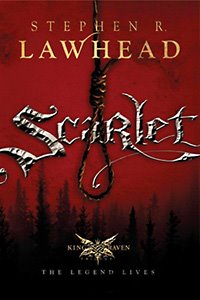How?
I’m stealing from my past. Leading up to a review of the latest book of the King Raven trilogy, Tuck, I present my past review of the second book of the series, Scarlet. Back when I remembered what happened!
From November ’07:
Yesterday for the CSFF tour I posted my review of the first book of the Raven King Trilogy, Hood. In it I mentioned that, while I have enjoyed many of Stephen Lawhead’s books, I have found him to be a streaky writer. In the Song of Albion series, the first two books were great, while the third one got a little tedious. I enjoyed The Iron Lance of the Celtic Crusades series, but bogged down in The Black Rood. Same with the Pendragon Cycle: loved the first book, lost interest in the second. Does the sophomore curse affect the second book of his new series, Scarlet?
I can answer a resounding NO.
Scarlet is a better book than its predecessor. Not that Hood wasn’t very enjoyable, but Scarlet improves some pacing issues and kept me intrigued more. It is the story of Will Scarlet, here a Saxon forester who is displaced from his lands and decides to seek out the infamous King Raven, who is tormenting the Normans (Ffreinc) who have invaded the lands of the Welsh. After joining Rhi Bran y Hud, Scarlet’s skill allows him to become a trusted member of Bran’s inner circle. As the fugitives work toward eventual freedom for their kingdom, Will becomes captured and is set for the noose (hence the cover of the book).
The book has an interesting structure. It is mainly from Will Scarlet’s point of view, first person, as he is in prison awaiting his hanging. He is telling his story to a priest who is acting as a scribe. It is a unique way to tell a story such as this, and it surprisingly works very well. There are some asides from Will to the poor Norman priest throughout, but instead of being distracting, it adds to the understanding of who Will is. The book occasionally shifts to third person when it moves into another character’s point of view.
Lawhead’s ability to weave an enchanting story from history and legend is unparalleled. His research and knowledge base is always top-notch, it is only a matter if he’s created a strong plot to go along with it. This time around he keeps the action near and the suspense palpable. The back and forth between Rhi Bran and the invaders is never fully decided throughout the book. There is also a nice tension with the politics running through the book that leaves us with an imposing cliffhanger that won’t be resolved until the third book, Tuck, comes out (which sadly won’t be for a while due to the author’s recent illness).
The storytelling sequence by Angharad is interesting yet the slowest part of the tale, much like in Hood. Occasionally the POV changes among different antagonists is confusing. However, this is a book with great setting, characters, and plot. I highly recommend the series so far, as it is a very good introduction to Stephen Lawhead.
See Becky Miller’s blog for the latest updates with other tour members, and perhaps I’ll have something original tomorrow!
